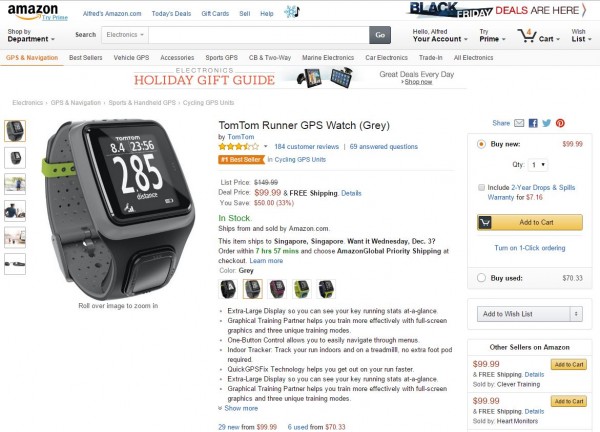
Window shopping on Amazon one afternoon on my PC, I chanced on a TomTom Runner GPS Watch which I had reviewed earlier this year. At a marked down price of US$99.99 (S$130), it got me interested enough to check the cost in Singapore.
To my surprise, the same fitness watch costs S$249 at the Sitex show this weekend. That’s almost twice as much as what it costs online.
For me, that neatly sums up this weekend’s online shopping buzz. It seems to have extended quickly from the United States to Singapore, catching many local retailers by surprise.
Sure, shipping things from Amazon is nothing new. I’ve been buying DVDs since 2000, when the online store’s prices were much cheaper than retailers here. What’s changed in recent years is the wider range of stuff you can buy and the wider acceptance of e-commerce.
Electronics, in particular, have become cheaper since last year, when Amazon started shipping them free to Singapore, as long as you bought at least US$125 of stuff. This Black Friday, expect Singaporeans to buy lots of stuff online instead of going to local brick and mortar retailers.
Indeed, more than half of Singaporeans shop online at least once a month, and a quarter of Singaporeans do so at least once a week, according to a survey by released by Visa last week.
In the 2000s, when online shops like Amazon became popular, many experts pointed to Singaporeans’ preference for touching and feeling a product and the cost of delivery in a small country where malls are easily reached.
Plus, people here didn’t have a habit of buying things on mail-in catalogs, which Americans were used to. How things have changed.
What’s strange is that many local players still haven’t taken the online, global competition seriously enough. When everyone on Facebook is sharing deals on Amazon and other online stores in the US, some shops here are still holding on to the suggested retail price – the highest price.
For tech gadgets, solid state drives (SSDs) present some of the starkest disparities. Samsung’s top-end model, the 850 Pro, is going for about US$320 on Amazon. Convert that, add 7 per cent Singapore tax and it still costs only about S$446. That’s a good S$193 less than the S$639 you pay at Sim Lim Square.
Also worth buying online are high-end network attached storage (NAS) devices. The QNap TS-420 model, which lets you pop in four hard disks for backup, costs US$299 (S$390) on Amazon. In Singapore, it goes for an eye-popping S$641.
There are downsides to buying online, obviously. Sometimes, the shipment may get delayed. Warranty issues are another thing.
But you question why the difference is so wide when Singapore is known to be an entrepot where the world’s goods pass through. Has price competition disappeared in recent years with the higher cost of living?
Retailers are surely not ignorant of the international competition. Perhaps many face the retail crunch of ever higher rental costs in Singapore. To survive, they keep selling the most popular stuff at the highest price possible.
Either that, or they sell to tourists who turn up for products which may be hard to get hold of back home. What happens if the tourism numbers fall, as can happen when the world economic outlook changes?
Perhaps this is a lesson in getting into online channels early. Some local players have done so, albeit carefully testing the water.
On local e-commerce site Lazada, for example, you’ll find a Palit GeForce GTX 980 Jetstream graphics card – among the fastest out there for gamers – going for S$750. This is down from the S$828 asked for at Sim Lim Square outlets.
The Palit card doesn’t seem to be sold on Amazon, but a similar GTX 980 card can go for around US$550 (S$717). Add tax and that comes up to about S$767, more than the local price.
Here, the Singapore distributor Convergent Systems is smart enough to work with a local online shop for this, despite risking its relationship with its bread and butter retail partners.
Yet, this may be the way forward if the consumer dollar is to remain in Singapore. Being a small market, distributors and retailers cannot always negotiate the best prices through smaller orders.
What they have to do is at least close the gap. Make it attractive to shop in Singapore once more. Failing that, each close of the year will see more dollars going to overseas, online shops, instead of Singapore retailers and bazaars like Sitex.






